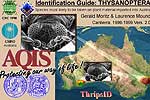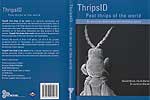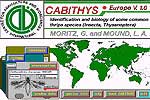The
idea of a computer determination key was born during the 1980s,
and led to an excellent practical system in a program called CABIKEY
written in Zortech C˛+ by Ian White (CAB International, |
|
1995 G.
Moritz and L. A. Mound |
|
| Thrips (the Order Thysanoptera) include about 5500 species worldwide, of which about 100 have been recorded as pests of crop plants by various workers. Several of these pest species are found only locally, or on a single crop species, but a considerable number of them are both widespread and with a wide range of host plants. Moreover, several species, such as Thrips palmi and Frankliniella occidentalis, have greatly extended their geographical range in recent years, presumably through the increased air traffic in live plants for the horticultural trade. This identification and information system deals primarily with the thrips of Europe, but many of the species included are pests in other parts of the world.This CABIKEY provides an illustrated, interactive key to the common adult Thysanoptera of Europe. It also provides a key to immature instars at family level for the three major families. It covers 120 of the 500 hundred species recorded from Europe, including the pest species and a broad range of taxa from the Order. Most thrips specimens collected from crops and their associated weeds in Europe are likely to be identifiable at species level. | |
1998
(1.0) and 1999 (2.0) G.
Moritz and L. A. Mound |
 |
| This CD ROM is Version 2.0 of a project for the Australian Quarantine Information Service (AQIS). The first edition (1998) of this interactive identification and information system provided AQIS staff with ready access to data on 50 species of thrips. In this second edition the total number of species is increased to 80. Moreover, each of these species is now independently illustrated. The species included are not only those species that seem most likely, on past experience, to be taken on plant material imported into Australia, but also a number of other species that are commonly associated with crops in other parts of the world. Despite this, it must be remembered that such an identification system deals with only a small percentage of the total world fauna of 5000 thrips species, and thus has very definite limitations. There is a high diversity in the thrips faunas in neighbouring areas of south east Asia and the Pacific, a very large number of species in South America, and a largely unknown thrips fauna in Africa. Thus, no identification system such as this should be expected to deal with all potential immigrant species. Expanding patterns of trading, including holiday travel, and particularly with Asian and Pacific countries, will undoubtedly bring new thrips species to Australia, some of which will be potential pests. Users of this identification system are advised that, if an intercepted and unknown thrips fails to match the descriptive text and photographs given here, then it is essential that the unknown should be compared with specimens from a good reference collection such as that at CSIRO Entomology, Canberra. | |
2001
Moritz G, Morris D, Mound LA |
 |
| This is the third edition of ThripsID.
The first two editions were produced under contract for use by the
staff of the Australian Quarantine Information Service, at the request
of Dr Glynn Maynard.Preparation of this greatly expanded third edition
has been facilitated by a contract with USDA Florida, and we are
grateful to Prof. Joe Funderburk for his interest in the project.
The LucID team at the University of Queensland, Brisbane, has given
us frequent encouragement and advice in the use of the software.
Dr Peter Cranston collaborated in the purchase of the digital camera
and image processing software, and this apparatus was also used to
produce his cd-rom Interactive Guide to Australian Aquatic Invertebrates.
The 1400 photomicrographs of slide-mounted specimens of 180 species
included here were taken with a JVC 3-chip camera, the multiple images
at different focal planes being processed and amalgamated to maximise
the depth of field, using the software Automontage from Synoptics
Ltd., Cambridge, UK. We are grateful to CSIRO Entomology, Canberra,
for providing working facilities, and to Dr Paul Ferrar, ACIAR, for
organising publication and distribution of this work. ThripsID: Pest Thrips of the World is an interactive identification and information system that provides a fully illustrated and user-friendly means of recognising most of the thrips species that have been recorded as pests in various parts of the world. This comprehensive package also offers a range of information on the hostplants, distributions and body structure of; these species. ThripsID: Pest Thrips of the World provides detail on the generic and family classification of this order of insects, the Thysanoptera. Covering 180 species of thrips in 95 genera, and all 9 of the currently recognised families of Thysanoptera, the identification system is richly illustrated with more than 1500 original photomicrographs, showing details of the structures of each species. ThripsID: Pest Thrips of the World will be a valuable resource for research workers, quarantine officers, economic entomologists and virologists, and also teachers and students who wish to know more about this order of insects. |
|
Further
information regarding the authors of this key can be obatined from
their websites: The authors will be pleased to receive comments at the following addresses: |
|
| Gerald Moritz: moritz@zoologie.uni-halle.de and Laurence Mound: Laurence.Mound@csiro.au | |

